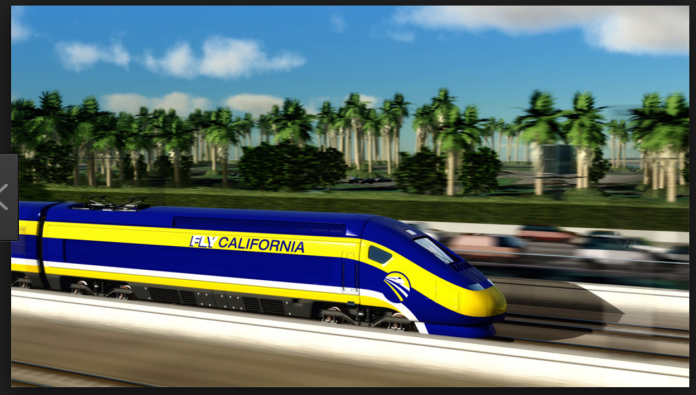Roger and Kathy Santos live on a property on the east side of Gilroy that has been in the family since 1930. Now there is a distinct possibility that their property will be on a collision course with the incoming high-speed rail line.
“I’d rather have it go through my house than around it,” Roger Santos, 72, said.
The Santoses are two of more than 100 Gilroy residents who attended the California High-Speed Rail Authority Community Open House Meeting at the I.F.D.E.S meeting hall on Old Gilroy Street on Tuesday. They are worried, not so much by whether their home could be seized under eminent domain law, but rather by how their property value will be affected by the rail line if it’s near their home.
“I’m concerned that it’s going to kill the value of my property to have high-speed train a stone’s throw from my house,” Roger Santos said. “It’s a hundred decibels at 200 mph. That’s loud.”
The Santoses do not want to lose their home, but the idea of living near raised viaducts and sound walls is not overly appealing on country property.
“One of the options runs through our property and we spent 17 years building our little five acres into a home,” said Steve Paszkiewicz, 61. “Suddenly there’s the prospect of a high-speed rail line going right through it. It’s unnerving.” Paskiewicz and his son Colin, 9, intently studied the potential plans for the construction of the station and rail line for the east side of town. He isn’t sure yet what the compensation will be.
“I’m waiting for them to select the path. Then we’ll decide to be worried or not to be worried. We’ll find out if we need to worry when they decide,” Paskiewicz said.
The California High-Speed Rail Authority hosted the discussion as part of its ongoing effort to communicate with local communities on what costs and benefits high-speed rail will bring to their areas. Compensation for the property, however, is yet to be determined.
“The environmental process will identify any properties we need to acquire for the right of way,” said California High-Speed Rail Authority Northern Regional Director Ben Tripousis.
“We’ll work with those property holders to acquire only that property we need for the project. There will be no wholesale acquisition of properties.”
The audience was in a feisty mood during the question and answer portion of the discussion. Concerns surrounding traffic, the noise of the trains, loss of agricultural land and impacts on local historical sights, along with property owner concerns, were among the concerns voiced by those in attendance. Sally Armendariz, 75, came equipped with a sign, showing how the downtown route will affect lower income residents.
“If we’re going to have high-speed rail, and it seems the state is ramming it down our throat, it better be on the east side of town,” said Armendariz. “It’s going to affect a lot of low-income people. Even if they pay fair market value of $200,0000, how are they going to afford new homes in Gilroy?”
Other residents were concerned about the historic parts of Gilroy and came to the meeting to further understand what those impacts will be.
“I want to know exactly what they have in plan for Gilroy and I want to see what they have on the table,” said Steve Seebart, 55, a member of the Gilroy Historic Heritage Committee.
“I like the idea of high-speed rail and I think it could revolutionize Gilroy and our relationship with Silicon Valley and the commuter problems around here. It’s hard to see how it exactly serves the city’s needs.”
The California High Speed Rail Authority is considering several options for the rail route. One option is to follow along with the existing railroad right of way through downtown Gilroy and the other is east of downtown near the Gilroy Outlets. Or they could do both, letting local trains go downtown and high speeds passing through to breeze by east of the Outlets.
The Rail Authority expects to finish the environmental process by the end of the year when they expect to release a draft proposal of the where the line will run. A preliminary decision is expected in August.
“This is an opportunity for Gilroy to become a regional hub in its own right,” Tripousis said. “The Transportation Agency of Monterey County is supportive of having a rail line extend to Monterey or Salinas. Hollister would like a connection to that spur line. It’s another way to get around the region without getting in their car and that would spur the station as an economic opportunity.”
Florance Lijon sees this as a way to commute to Los Angeles for work.
“I have family in L.A, but I also do acting,” she said. “It would be great to get a job in L.A. and to take the train to get there.I just hope it’s not too noisy. I’m excited to see what’s going to happen.”
So far the first phase of the project, which is to connect a 520-mile line from San Francisco to L.A., is underway and slated to be completed by 2025. Travel time from downtown San Francisco to L.A. is expected to take 2 hours and 40 minutes. The High-Speed Rail Authority compares the train to other high-speed rail lines in Europe, China and Japan. Currently, 119 miles of line are under construction between Bakersfield and Merced which has cost approximately $3 billion. These funds are largely from the Federal American Recovery and Reinvestment Act passed in 2009. The act, passed in response to the Great Recession of 2009, will spend more than $800 billion on infrastructure projects throughout the country.
To assist Gilroy to prepare for the new station, the California High-Speed Rail Authority has committed $600,000 for infrastructure projects. While tickets costs are still being developed, it’s expected that the rail fares will be roughly 80 percent of what the airline fees would be between the same cities.














